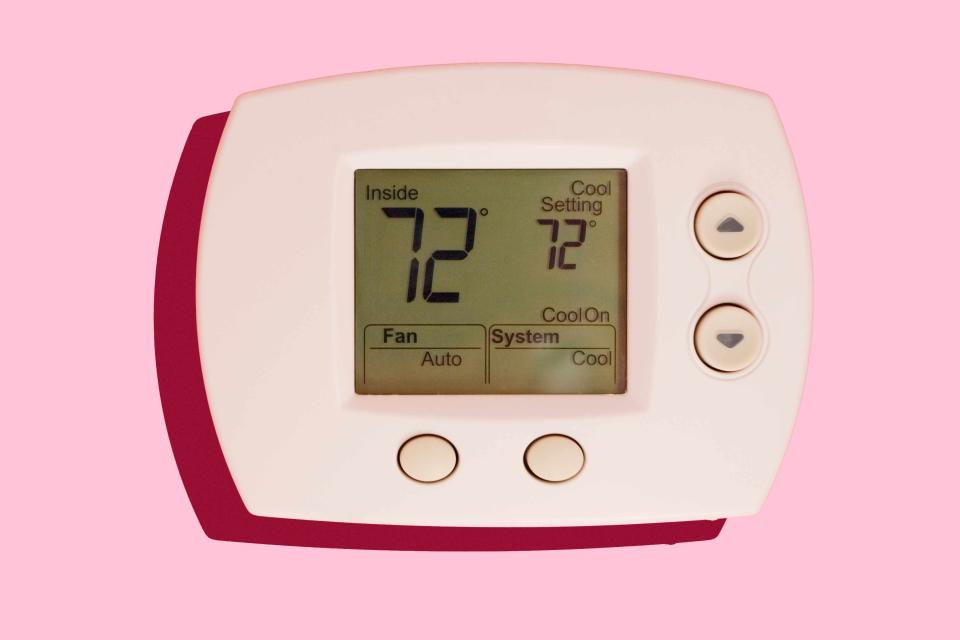What Temperature Should You Set Your Thermostat in the Spring?
Save on energy bills and keep your HVAC system in good shape.

Tetra Images/Getty Images
As the temperatures finally start to inch upward—and the sun spends more time in the sky—you’re probably more preoccupied with thoughts of enjoying good weather and less concerned about what temperature you should set your thermostat for spring. However, knowing how to adjust your indoor HVAC system for the new season can help you stay more comfortable and save you cash, especially given the sometimes aggressive temperature fluctuations from morning to night and even day to day.
“With larger temperature swings in the springtime, setting your thermostat can be challenging,” says Traci Fournier, vice president of operations of One Hour Heating & Air Conditioning. “It’s important to find the correct setting for your home throughout this season to maintain your family’s comfort, ensure you are not overworking your HVAC system, and strive toward a lower energy bill.”
So what’s the ideal house temperature for spring? Let’s dive in.
Related: These Are the Clever Energy Saving Tips You'll Wish You Knew Sooner
What is the Right Temperature to Set the Thermostat in Spring?
Both of the HVAC pros we spoke to agreed that an indoor thermostat temperature between 68 and 70 degrees Fahrenheit during waking hours was ideal for spring. This is a comfortable temperature—not too hot and not too cold—and prevents your HVAC from overworking.
“If possible, a thermostat that lets you select both heating and cooling options at the same time is ideal, as this can keep the internal temperature of your home within a nice band of temperatures without working either the heater or the AC too hard,” notes Colin Young, an HVAC specialist with HVAC Gnome in Westminster, Colorado.
Tips
Spring weather spells storms, which means electrical outages! If a large storm is on the front, Young recommends raising the temperature beforehand as a way to “pre-heat” your home in case the electric goes out.
The Best Nighttime Thermostat Temperature for Spring
At night, you can lower the temperature. Shoot for anywhere between 60 and 67 degrees Fahrenheit depending on your household preferences. Again, this keeps you comfortable—and encourages good sleep—without creating too drastic of a temperature swing from day to night and then day again.
“In most cases, trying to get some shut-eye outside this recommended temperature range will make it harder to fall or stay asleep,” Fournier notes. “One of the ways our bodies ‘turn off’ for the night is by lowering its core temperature gradually, and our bodies can’t reach this optimal internal temperature in a room that’s too hot.”
Conversely, in a room that’s too cold, our bodies have to work harder to stay warm, which can impact our sleep, as well. In other words: You don’t need to be a hero when it comes to setting the thermostat at night during spring. Stay comfortable!
Related: 10 Things You Can Do in the Evening to Sleep Better at Night
Should You Change The Thermostat When You’re Gone?
There are differing philosophies when it comes to changing your indoor temperature—or turning off your HVAC entirely—when away from the house. Generally speaking, our experts agreed it’s best to avoid huge temperature fluctuations in short periods (less than eight hours). So, it’s better to leave your thermostat alone when you’re simply leaving for work or on an overnight trip.
“The HVAC system is going to work much harder changing the home temperature from 55 to 70 degrees Fahrenheit than it would have just maintaining the 70-degrees temperature for the day,” Young explains. “This is especially true if your house is well insulated and the windows and such are closed while you're away.”
However, if you’re gone for several days or longer—with nobody in the home—then you can adjust the thermostat. In cold weather, he recommends setting it to between 40 and 50 degrees Fahrenheit to prevent your home from reaching freezing temperatures, which can affect pipes. If it’s warmer, you can set the AC to about five-degrees warmer than what you usually keep your temperature.
5 Energy-Saving Tips for Spring
Not keen on seeing a sky-high electric bill? Here are some ways you can lower costs and keep your HVAC in tip-top shape.
Check Seals & Insulation
Double check that all windows and doors are properly sealed, Young says. Also make sure insulation and R-ratings of your home are good for retaining temperature.
Circulate Air
When temps allow, circulate cool air overnight, or warm air during the day, with ceiling fans. Turn off your HVAC system during these times so it’s working against natural ventilation.
Leverage Windows
“On a warm spring day, open your windows to let in the spring breeze for cross-ventilation and to cool your home,” Fournier says. “For those spring days that still feel like winter, open your blinds or curtains to let in direct sunlight that will naturally warm your home.”
Check Thermostat Location
Thermostat placement is super important. “Where the temperature is measured in your home will determine how the HVAC system behaves,” Young explains. “Make sure it is located in a central and normally used area of the home.”
Switch to a Programmable Thermostat
To cut down on energy cost and increase the home’s comfort level, Fournier recommends investing in a programmable thermostat. “Instead of constantly readjusting the temperature, you can set the thermostat to turn on, off, or change temperatures when it makes sense.”
Related: What Temperature Should You Set Your Air Conditioner in the Summer?
For more Real Simple news, make sure to sign up for our newsletter!
Read the original article on Real Simple.

